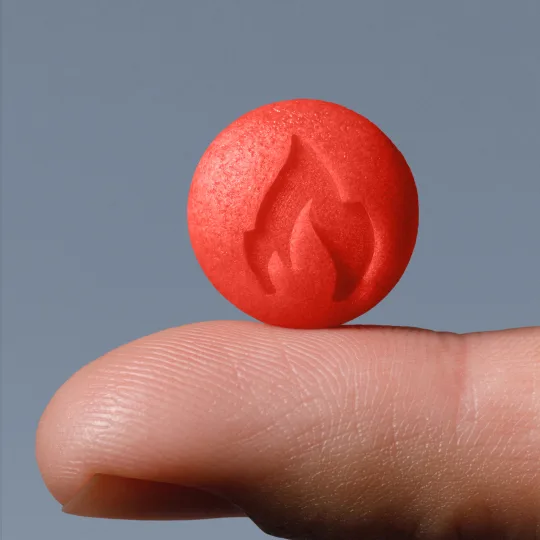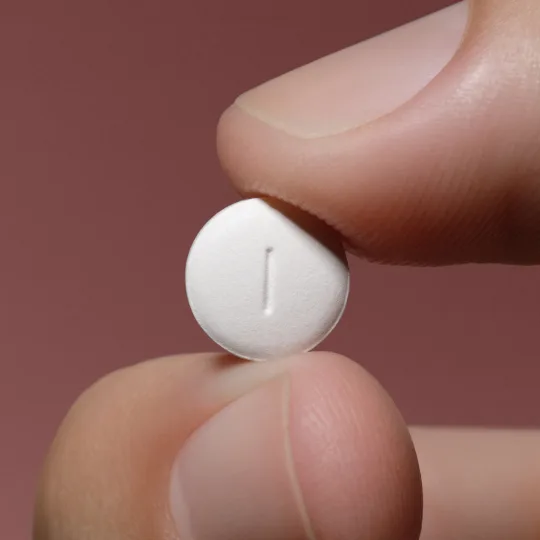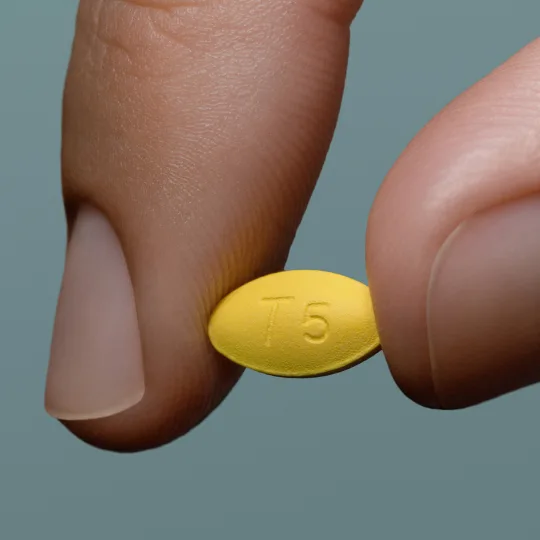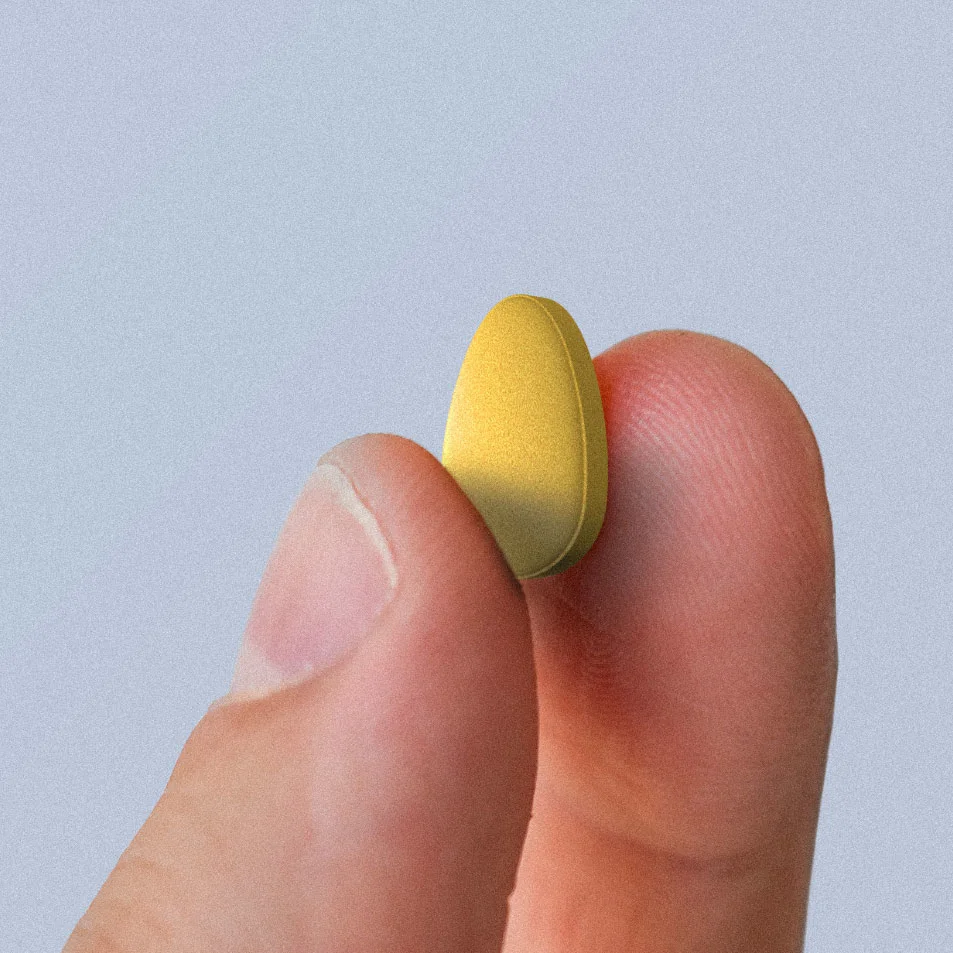Key takeaways
Cialis and Viagra should not be taken together without medical supervision as combining the two can cause dangerous side effects.
Ro Sparks combines the active ingredients of Cialis and Viagra into one fast-acting sublingual medication.
Talk to a healthcare provider about your treatment options, especially if you have health conditions like heart disease, diabetes, or performance anxiety that could be affecting your sexual performance.
Here's what we'll cover
Key takeaways
Cialis and Viagra should not be taken together without medical supervision as combining the two can cause dangerous side effects.
Ro Sparks combines the active ingredients of Cialis and Viagra into one fast-acting sublingual medication.
Talk to a healthcare provider about your treatment options, especially if you have health conditions like heart disease, diabetes, or performance anxiety that could be affecting your sexual performance.
Taking Viagra (sildenafil) and Cialis (tadalafil) together is not recommended without medical supervision. That said, there are instances where a healthcare provider might recommend a safe, custom approach. In most cases, this involves compounding by a pharmacist who tailors the medication to your specific needs based on a doctor’s prescription.
While products such as Ro Sparks allow you to combine Viagra and Cialis in a safe, managed way, taking these two medications together on your own could lead to serious side effects such as drops in blood pressure, dizziness, or fainting.
Read on to learn more about taking Viagra and Cialis together if you’re considering taking both meds.
Can you take low-dose Viagra and Cialis together?
Yes, you can take Viagra and Cialis together but only in some instances where a healthcare provider might recommend a safe, custom approach. Taking Cialis and Viagra together isn’t something you should try on your own—even if the dosages are lower.
For example, Ro Sparks is a prescription treatment for ED that combines lower doses of both medications into one sublingual tablet, designed for faster action and longer-lasting effects.
Viagra can start working in just 12 minutes for some people (though this is quicker than average), but it wears off within a few hours, while Cialis stays active in the body much longer. This means that combining the two could provide a better experience overall. However, taking full doses of both medications without a provider’s supervision could cause complications like drops in blood pressure, dizziness, or fainting.
There are situations where combining Cialis and Viagra makes sense—but only under medical supervision.
Have better sex with Ro
Precautions when taking Viagra and Cialis together
What to consider before you combine Viagra and Cialis:
Wait at least 24 hours between doses: Cialis and Viagra are both PDE5 inhibitors that affect blood flow and can lower blood pressure. According to the prescribing information, you should wait at least 24 hours between doses to avoid dangerously low blood pressure. Of course, this is for a situation where you have not discussed with your healthcare provider that you might be taking both of the medications together.
Be mindful of medication interactions: You should not take Cialis or Viagra with nitrates (used for chest pain) or alpha-blockers (used for high blood pressure or prostate problems), as this combination can cause a drop in blood pressure.
Certain populations should use caution when taking Cialis and Viagra:
Adults aged 65 or older: Older adults may need lower doses due to slower drug metabolism.
Those with liver or kidney issues: These conditions may increase the medications' effects, requiring dose adjustments.
Those with heart issues: Ask your doctor if sexual activity is safe for you if you have heart disease or have experienced recent heart attacks or strokes.
It’s important to recognize serious side effects when taking these medications together. Seek immediate medical help if you experience chest pain, sudden vision or hearing loss, or an erection lasting more than four hours.
Attempting to mix Cialis and Viagra on your own can be risky and is not recommended. If you’re curious about whether using both medications might work for you, talk to a healthcare provider who knows your medical history.
Can you take Cialis in the morning and Viagra at night?
Taking Cialis in the morning and Viagra is not generally recommended unless specifically directed by a healthcare provider.
Since both Cialis (tadalafil) and Viagra (sildenafil) belong to the same class of drugs and affect the same biological pathway, combining these medications without proper guidance can lead to serious health risks, particularly low blood pressure.
It is important to wait at least 24 hours between full doses of PDE5 inhibitors to reduce the risk of side effects like low blood pressure, dizziness, and fainting. This is especially important for people taking medications for high blood pressure or heart conditions, as PDE5 inhibitors can interact with nitrates and alpha-blockers, compounding the risk of a dangerous drop in blood pressure.
In some cases, a healthcare provider may prescribe daily low-dose Cialis alongside occasional Viagra to be taken as needed. This approach may help improve flexibility in timing sexual activity while minimizing risks, but only under strict medical supervision. There are other ways to take these medications together, but you should always discuss this type of dosing closely with a healthcare provider.
How do you take Viagra and Cialis together?
Mixing Viagra and Cialis together isn’t as simple as popping both pills—it requires careful dosing that only a healthcare provider can prescribe. This approach can be accomplished through compounding, where a pharmacist creates a custom medication by combining specific amounts of active ingredients based on your individual needs.
Compounding allows providers to deliver a more personalized ED treatment than what’s commercially available. Instead of taking separate doses of Viagra and Cialis, compounded formulations combine both medications into a single, tailored dose. Compounding pharmacies are overseen by the U.S. Food and Drug Administration (FDA) and state Boards of Pharmacy, ensuring they meet both federal and state regulations for compounding. Unlike commercially manufactured drugs, compounded medications, when prepared in accordance with these regulations, are exempt from the FDA’s new drug approval process and certain other requirements applicable to drug manufacturers.
Where can you get combined Viagra and Cialis?
If you’re interested in a combination of Viagra and Cialis, Ro Sparks can be a great option. Ro Sparks blends the active ingredients of both medications into a fast-acting sublingual tablet.
Unlike standard pills that you swallow whole, Ro Sparks dissolve under your tongue, allowing the medication to enter your bloodstream directly.
This means they can work faster—sometimes in as little as 15 minutes—and can keep you ready for sex for up to 36 hours. Taking the medication this way may also avoid any delays caused by food or digestion, giving you more predictable results.
Since ED medications only work when you’re sexually aroused, you can take your time getting in the mood while the treatment takes effect.
If you’re interested in trying a combination ED treatment like Ro Sparks, the process is safe and straightforward. Here’s what to expect:
Complete an online health assessment: Start by filling out a secure online questionnaire about your medical history, current medications, and ED symptoms. This evaluation helps the healthcare provider understand your specific needs to recommend the most suitable treatment. The assessment takes about 20 minutes and covers key health details needed for a personalized prescription.
Consult with a licensed healthcare provider: After submitting your assessment, a licensed provider will review your information within 24 hours. They’ll consider your medical history, symptoms, and treatment preferences. If needed, they may reach out with follow-up questions to ensure they have a full understanding of your health profile.
Receive your prescription: If Ro Sparks is prescribed, your medication will be prepared and shipped directly to your home in discreet packaging. Ro only works with FDA-regulated manufacturers, so you can be confident your prescription meets strict safety and quality standards.
Get ongoing support: After starting your treatment, you’ll have access to unlimited follow-ups with Ro’s healthcare team. Whether you need a dosage adjustment, have questions about side effects, or want to discuss your progress, the team is available to provide continued care and guidance.
What are the differences between Cialis and Viagra?
The biggest difference between Cialis and Viagra is how long their effects last:
Viagra can typically work for about four hours after taking a dose. This makes it more suitable for planned sexual activity, as its effects are limited to a shorter window.
Cialis can last much longer—up to 36 hours—which is why it is sometimes referred to as “The Weekend Pill.” Its extended duration provides more flexibility, making it easier to have sex without carefully planning when to take the medication.
The timing and frequency of taking Cialis and Viagra also differ:
Viagra is usually taken only when needed, about 30 to 60 minutes before sex. Its absorption can be slowed down if you take it along with a heavy or high-fat meal, which means it may take longer to work.
Cialis offers two different dosing options. It can be taken as needed, about 30 minutes before sexual activity, or as a daily low-dose tablet. The daily option keeps the medication in your system consistently, allowing for more spontaneous sexual activity.
Unlike Viagra, Cialis can be taken with or without food, as meals do not impact its effectiveness.
The dosage for both medications depends on how often you expect to have sex and how your body responds to the treatment. The differences in dosages are:
Viagra is usually prescribed in a single dose often starting at 50 mg, taken as needed before sexual activity. Depending on how effective the treatment is and whether any side effects occur, your healthcare provider may lower the dose to 25 mg or up the dose to 100 mg.
Cialis has more dosing flexibility. If taken daily, the typical starting dose is 2.5 mg, which may be increased to 5 mg if necessary. For occasional use, the recommended starting dose is 10 mg, with adjustments up to 20 mg if needed.
Your healthcare provider will help determine the best dosage for you based on your lifestyle, medical history, and response to the medication.
How does Viagra and Cialis work?
Viagra and Cialis help improve blood flow to the penis, making it easier to get and keep an erection when you're sexually aroused. They belong to a group of medications called PDE5 inhibitors, which block an enzyme called phosphodiesterase type 5 (PDE5).
Here’s the science behind it:
When you're sexually aroused, your brain releases signals that produce a chemical called cyclic guanosine monophosphate (cGMP).
This chemical relaxes the muscles in the penis, allowing more blood to flow into two sponge-like chambers called the corpora cavernosa.
As these chambers fill with blood, the blood gets trapped, resulting in a natural erection.
After ejaculation, an enzyme called phosphodiesterase type 5 (PDE5) breaks down cGMP, causing blood to leave the penis and the erection to go away.
ED happens when the body doesn’t produce enough cGMP or when PDE5 acts too soon, cutting off blood flow before an erection can fully develop or last long enough. By boosting cGMP levels, Viagra and Cialis keep the blood flowing where it’s needed.
When this process doesn’t work as it should, it can result in ED. Sometimes, PDE5 acts too soon, breaking down cGMP before enough blood has entered the penis. Without sufficient blood flow, an erection either won’t happen or won’t last.
How to choose between Viagra or Cialis?
Choosing between Cialis and Viagra depends on your personal preferences, how often you expect to have sex, and how your body responds to each medication.
Viagra may be the better option if you prefer taking a pill only when needed and want something with a shorter active window. Its effects wear off after about four hours, making it a good choice for occasional use if you don’t want to have the medication in your system for longer.
Cialis may be a better fit if you want more flexibility and prefer a longer-lasting effect––its extended duration allows for more spontaneity.
With Cialis, there’s also the option of a daily low-dose tablet that works for those who want a consistent routine and would like to be able to have sex at any time without needing to time medication around it.
How long each medication lasts in your body may depend on your age, kidney or liver function, and if you’re taking certain other medications. In these situations, your healthcare provider may recommend a different dosage of Cialis or Viagra to adjust for differences in how your body processes the medication.
Ultimately, your healthcare provider can help you determine which medication is the safest and most effective choice based on your health history, treatment goals, and how your body responds to each option.
Which is better for you: Viagra or Cialis?
Since both Viagra and Cialis are prescription medications, you’ll need to consult a healthcare provider before starting treatment. During this conversation, be prepared to discuss your medical history, current medications, and any supplements you are taking.
This helps identify potential drug interactions and can check whether the treatment is a safe option for you.
Drug interactions
Both Viagra and Cialis can interact with other medications, particularly those used for heart conditions and high blood pressure. Your healthcare provider will assess these risks and adjust your treatment if needed.
Nitrates: Combining ED medications with nitrates (used to treat chest pain or heart conditions) can cause a dangerous drop in blood pressure. Nitrates include nitroglycerin but nitrites including recreational “poppers” can also be dangerous. Such combinations can be life-threatening and should always be avoided.
Alpha-Blockers: Alpha-blockers, prescribed for high blood pressure or enlarged prostate (BPH), can also lower blood pressure. If you take alpha-blockers such as terazosin or tamsulosin, your provider may adjust your ED medication dosage or recommend an alternative.
CYP3A4 Interactions: Certain drugs like antifungals (ketoconazole, HIV medications, and antibiotics like erythromycin) can interfere with how your body processes Viagra and Cialis. This might increase the risk of side effects.
Remember that this list is not exhaustive. Always let your healthcare provider know about all medications and supplements you’re taking to avoid potential complications.
Side effects
Side effects are generally uncommon with both Viagra and Cialis––but it’s important to know what to look out for.
Here's a breakdown of the main side effects associated with each.
Viagra (sildenafil) side effects:
Headaches
Facial flushing
Indigestion
Back pain
Stuffy nose
Nausea
Dizziness
Cialis (tadalafil) side effects:
Headaches
Indigestion
Stuffy nose
Back pain (more common than with Viagra)
Muscle aches (unique to Cialis, often in the lower back, thighs, or glutes)
Most side effects from Cialis and Viagra are mild and usually go away on their own. However, because Cialis stays in your system longer than Viagra, its side effects—such as headaches or muscle aches—can last longer as well.
In rare cases, these medications can cause more serious reactions. Get immediate medical attention if you experience:
Changes in vision like blurred vision or loss of vision.
Sudden or partial loss of hearing, sometimes accompanied by ringing in the ears.
An erection lasting more than four hours (priapism).
Since these effects can vary from person to person, it’s important to try different options and figure out the one that works best for you by continuing to discuss with your healthcare provider.
Sexual activity can strain your heart, and may not be safe if you have a history of heart conditions or heart disease. If you have high blood pressure, it’s generally safe to take Cialis or Viagra but your healthcare provider may suggest checking your blood pressure or adjusting your dosage if necessary depending on what medications you are taking.
Check with your provider if you have concerns about your heart health before you consider medication to treat your ED.
What if Cialis or Viagra isn’t working for me?
If Cialis or Viagra isn’t working for you, there are other options you can consider. Here’s a quick overview––but remember these aren’t exhaustive. Your healthcare provider can help determine if other treatment modalities might be better suited for you.
Other ED medications
Studies show that up to half of people who don’t initially respond to one PDE5 inhibitor will find benefit with a different one. If you’ve been using low-dose PDE5 inhibitors as needed and they are not giving you the results you want, you could consider other options.
One of those options is taking Cialis every day. Daily Cialis can be taken as a low-dose medication at the same time every day to provide a consistent dose of tadalafil. This allows it to build up in your system over time to keep you ready for sex. Ro also offers Daily Rise Gummies, a daily dose of tadalafil in gummy form.
Your healthcare provider can guide you through your options and adjust your prescription based on how your body reacts.
Try alternative ED treatments
If medications like Viagra or Cialis aren’t working anymore, there are other options to try.
Vacuum constriction devices (penis pumps)
While the idea of a mechanical device instead of medication can seem unsettling, these devices are particularly useful for anyone who has ED because of physical injury or surgery. This includes ED due to procedures for prostate or bladder cancer.
Hormone therapy
If your ED is linked to low testosterone levels, your healthcare provider might suggest testosterone replacement therapy. This treatment can help balance hormone levels, boosting both libido and sexual performance. A simple blood test can determine if a hormonal imbalance is contributing to your symptoms.
Lifestyle changes
Lifestyle choices can play a role in ED. This includes smoking, an unhealthy diet, limited physical activity, excess weight, and frequent alcohol. All of these factors may impact blood flow by causing inflammation and reducing nitric oxide production—a molecule essential for healthy circulation.
Making positive changes, such as eating a balanced diet, staying active, and maintaining a healthy weight, can support better erectile function. Research suggests that healthier habits may even improve or reverse ED symptoms, especially in people with conditions like obesity or metabolic syndrome.
Bottom line: can you take Cialis and Viagra together?
In some cases, Cialis and Viagra can be used together, but it depends on the dosage and must always be done under the guidance of a healthcare provider. Combining these medications without proper supervision can lead to serious side effects, such as dangerously low blood pressure.
Sexual medicine continues to advance toward more personalized care, and there are situations where a combination of Viagra and Cialis may provide the right balance for a patient’s needs. Treatments like compounded medications, such as Ro Sparks, are specifically designed to safely combine the active ingredients of both drugs in safe amounts under medical supervision.
Your healthcare provider can help you decide whether a combination treatment is appropriate and guide you in addressing the underlying causes of ED. These may include psychological factors like anxiety, depression, or performance-related stress.
If you’re exploring ED treatment options, speak with a licensed healthcare provider who can help you find a safe and effective solution tailored to your needs.
DISCLAIMER
If you have any medical questions or concerns, please talk to your healthcare provider. The articles on Health Guide are underpinned by peer-reviewed research and information drawn from medical societies and governmental agencies. However, they are not a substitute for professional medical advice, diagnosis, or treatment.
Cialis Important Safety Information: Read more about serious warnings and safety info.
Viagra Important Safety Information: Read more about serious warnings and safety info.
References
DailyMed. (2022). Tadalafil tablet, coated. Retrieved from https://dailymed.nlm.nih.gov/dailymed/drugInfo.cfm?setid=abcb2cda-9b3f-45f6-ad5f-c2370b0dd114
Deveci, S., Peşkircioğlu, L., Aygün, C., et al. (2004). Sublingual sildenafil in the treatment of erectile dysfunction: Faster onset of action with less dose. International Journal of Urology, 11(11), 989–992. doi: 10.1111/j.1442-2042.2004.00933.x. Retrieved from https://pubmed.ncbi.nlm.nih.gov/15509203/
Eardley, I., Ellis, P., Boolell, M., et al. (2002). Onset and duration of action of sildenafil for the treatment of erectile dysfunction. British Journal of Clinical Pharmacology, 53 Suppl 1(Suppl 1), 61S–65S. doi: 10.1046/j.0306-5251.2001.00034.x. Retrieved from https://pmc.ncbi.nlm.nih.gov/articles/PMC1874251/
Eli Lilly & Company. (2023). Cialis (tadalafil) tablets, for oral use: Highlights of prescribing information. Retrieved from https://pi.lilly.com/us/cialis-pi.pdf
Gong, B., Ma, M., Xie, W., et al. (2017). Direct comparison of tadalafil with sildenafil for the treatment of erectile dysfunction: A systematic review and meta-analysis. International Urology and Nephrology, 49(10), 1731–1740. doi: 10.1007/s11255-017-1644-5. Retrieved from https://link.springer.com/article/10.1007/s11255-017-1644-5
Leslie, S. W. & Sooriyamoorthy, T. (2024). Erectile Dysfunction. StatPearls. Retrieved from https://pubmed.ncbi.nlm.nih.gov/32965924/
Maiorino, M. I., Bellastella, G., & Esposito, K. (2015). Lifestyle modifications and erectile dysfunction: what can be expected?. Asian Journal of Andrology, 17(1), 5–10. doi: 10.4103/1008-682X.137687. Retrieved from https://pubmed.ncbi.nlm.nih.gov/25248655/
U.S. Food and Drug Administration. (2017). Highlights of prescribing information: Viagra (sildenafil citrate) tablets, for oral use. Retrieved from https://www.accessdata.fda.gov/drugsatfda_docs/label/2017/020895s048lbl.pdf


















